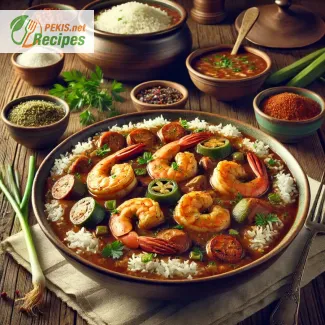
Few dishes encapsulate the rich culinary heritage of the United States like Traditional New Orleans Gumbo. Born in the vibrant kitchens of Louisiana, this iconic dish is a harmonious blend of diverse cultural influences, including French, Spanish, African, and Native American cuisines. It’s a soul-warming stew that combines bold flavors, unique ingredients, and meticulous preparation to create a dish that’s as deeply rooted in history as it is in flavor.
A Journey Through Gumbo's Origins
Gumbo’s story begins in the melting pot of New Orleans, a city renowned for its culinary creativity and multiculturalism. The word "gumbo" is thought to derive from the West African term "ki ngombo," which refers to okra—a key thickening agent in some versions of the dish. Over time, gumbo has evolved into a dish that reflects the complex cultural tapestry of the region. It fuses African traditions, French roux techniques, Spanish spices, and Native American herbs into a singular masterpiece.
No two gumbos are the same, and that’s part of the magic. While some recipes rely on a deep, nutty roux to create the base, others use okra or filé powder (ground sassafras leaves) for thickening. The diversity of ingredients—ranging from shrimp and crab to sausage and chicken—means that every bite tells a different story.
The Secret to Perfect Gumbo: Patience and Precision
Cooking gumbo is as much about the process as it is about the ingredients. At its heart is the roux, a carefully cooked mixture of fat and flour that forms the backbone of the dish. The roux must be stirred constantly and lovingly, often for up to 45 minutes, to achieve its signature deep, caramelized color. This patience pays off, as the roux imbues the gumbo with a richness that no shortcuts can replicate.
Once the roux is ready, the “holy trinity” of Louisiana cuisine—onions, bell peppers, and celery—is added. These vegetables, sautéed to perfection, release a fragrant aroma that sets the stage for the dish’s bold and complex flavors.
From there, the magic truly begins. Seafood lovers might add plump shrimp, succulent crab, and tender oysters, while others opt for smoky andouille sausage, chicken, or even duck. Each ingredient brings its own depth, creating a dish that is simultaneously hearty and elegant.
A Symphony of Spices and Ingredients
What sets gumbo apart is its vivid seasoning profile. Classic Cajun spices like paprika, cayenne pepper, thyme, and bay leaves work together to create layers of flavor that unfold with every bite. Many recipes also incorporate file powder, which not only thickens the gumbo but adds a distinct earthy flavor that’s uniquely Louisiana.
Accompanied by a generous serving of fluffy white rice, gumbo transforms into a complete meal. The rice serves as the perfect base, soaking up the bold flavors and offering a comforting contrast to the stew’s complexity.
More Than a Meal: An Experience
Traditional New Orleans Gumbo isn’t just food—it’s a cultural experience. It’s the centerpiece of family gatherings, neighborhood potlucks, and festive celebrations like Mardi Gras. A steaming bowl of gumbo brings people together, fostering a sense of community and shared tradition.
Beyond its taste, gumbo embodies the spirit of New Orleans itself: bold, diverse, and unapologetically vibrant. Whether you’re savoring it in a rustic French Quarter café or recreating it in your own kitchen, gumbo offers a taste of the South that lingers long after the meal is over.
Why Gumbo Remains a Timeless Classic
In a world of ever-changing food trends, gumbo remains an enduring symbol of Southern hospitality and resilience. Its adaptability allows it to evolve while staying true to its roots, making it just as relevant today as it was centuries ago.
Whether you’re a seasoned chef or a curious home cook, preparing gumbo is a labor of love that rewards you with an unforgettable culinary experience. Each pot of gumbo is a tribute to the countless hands that have stirred it before, a celebration of history, and a reminder of the enduring power of food to bring us together.
Indulging in Traditional New Orleans Gumbo is more than just enjoying a meal—it’s an invitation to explore the rich cultural heritage of one of America’s most storied regions. So grab a spoon, let the flavors transport you to the bustling streets of New Orleans, and savor a dish that has stood the test of time.
- Prepare the Roux:
- Heat the oil in a large heavy-bottomed pot over medium heat. Add the flour and stir constantly with a wooden spoon or whisk to create a roux. Cook for 30–45 minutes, stirring constantly, until the roux reaches a dark brown, caramelized color. Be careful not to burn it.
- Add Vegetables:
- Stir in the diced onions, bell peppers, and celery (the "holy trinity") into the roux. Cook for 10 minutes until softened. Add the garlic and cook for 1 more minute.
- Cook the Protein:
- Add the sliced sausage and cubed chicken to the pot. Cook until the chicken is browned and the sausage releases its smoky flavor, about 5–7 minutes.
- Add Liquids and Seasonings:
- Pour in the chicken stock and water. Add the bay leaves, thyme, Cajun seasoning, paprika, salt, pepper, and cayenne. Stir well. Bring the mixture to a boil, then reduce the heat and let it simmer uncovered for 1 hour.
- Incorporate Okra or Filé Powder:
- Add the sliced okra or filé powder for thickening. Simmer for another 30 minutes, stirring occasionally.
- Add Seafood:
- Stir in the shrimp and crab meat. Simmer for an additional 10 minutes or until the shrimp are pink and fully cooked.
- Adjust and Garnish:
- Taste the gumbo and adjust seasoning if needed. Discard the bay leaves. Garnish with chopped parsley and spring onions.
- Serve:
- Ladle the gumbo over warm white rice and serve immediately.
Enhancing the Traditional New Orleans Gumbo Recipe: Professional Tips for Customization and Perfection
Traditional New Orleans Gumbo is a masterpiece in itself, a reflection of culinary history and diversity. However, every recipe can be fine-tuned to cater to personal preferences, dietary requirements, or creative experimentation. Below, you’ll find professional advice on how to adjust, enhance, and elevate the Traditional New Orleans Gumbo while staying true to its essence.
1. Customizing the Roux for Depth and Texture
The roux forms the backbone of gumbo, setting the tone for the entire dish. Depending on your taste preferences, you can make adjustments to enhance its complexity:
- For a richer flavor: Use a mix of vegetable oil and butter for the roux. Butter provides a nutty aroma and depth, though it requires extra care to prevent burning.
- For a healthier option: Swap the oil for olive oil, but keep in mind that olive oil has a lower smoke point and may alter the flavor subtly.
- Experiment with gluten-free options: Use gluten-free flour (like rice or almond flour) to create a roux suitable for those with gluten sensitivities. Stir consistently to avoid clumping, as these flours behave differently from all-purpose flour.
2. Balancing Spices for a Personalized Flavor Profile
Gumbo's Cajun seasoning gives it its characteristic boldness, but you can tweak the spice blend to suit your palate:
- For more heat: Increase the cayenne pepper or add finely diced fresh chili peppers.
- For a milder gumbo: Reduce the cayenne and paprika, and balance with a bit more thyme or bay leaves to retain depth.
- Enhancing umami: Add a splash of fish sauce or Worcestershire sauce. These ingredients bring out the savory notes of the seafood and meat.
3. Protein Variations for Dietary Preferences
The mix of chicken, sausage, and seafood provides gumbo with its hearty appeal, but there’s plenty of room for customization:
- Vegetarian gumbo: Replace the meat with hearty vegetables such as zucchini, eggplant, or mushrooms. Add plant-based sausages or smoked tofu for a meaty texture.
- Shellfish allergies: Omit shrimp and crab, doubling the chicken or sausage. Alternatively, substitute with firm white fish, like cod, or even diced turkey.
- Kosher or halal adjustments: Replace pork sausage with chicken or beef sausage to meet dietary restrictions.
4. Thickening Agents: Experimenting with Texture
The thickening component of gumbo is crucial for its consistency. The traditional recipe uses roux, okra, or filé powder, but you can experiment with alternatives:
- For a silky texture: Blend half of the okra into a puree before adding it to the pot. This will thicken the gumbo without changing the flavor significantly.
- Non-traditional thickeners: Cornstarch or arrowroot can be used for a lighter texture. Dissolve in a small amount of cold water and stir in during the last 15 minutes of cooking.
- Avoiding okra’s sliminess: Add the okra later in the cooking process, as overcooking increases its viscosity.
5. Adjusting Liquids for Flavor and Consistency
The balance between chicken stock and water affects gumbo’s flavor concentration.
- For a richer broth: Replace the water with additional chicken stock or seafood stock. Homemade stock, with roasted chicken or shrimp shells, adds unbeatable flavor.
- To tone down the saltiness: Use low-sodium stock if you’re including salted sausage, or dilute the dish with extra water during cooking.
6. Enhancing the Presentation and Garnishing
While gumbo is known for its rustic charm, presentation plays a role in elevating its appeal:
- Garnish strategically: Sprinkle freshly chopped parsley, spring onions, or even a dash of paprika on top of the served gumbo to add visual contrast.
- Serving vessels: Use wide, shallow bowls to showcase the gumbo’s vibrant ingredients. Pair with perfectly steamed white rice, or experiment with wild or brown rice for a nutty flavor.
7. Making Gumbo Healthier Without Sacrificing Flavor
Traditional gumbo can be calorie-dense due to its roux and sausage. Here’s how to make it healthier while maintaining authenticity:
- Reduce fat: Drain excess oil after cooking the sausage or use leaner meats like skinless chicken breast instead of thighs.
- Increase fiber: Add more vegetables such as spinach, kale, or carrots to boost the nutritional profile.
- Lower sodium: Use unsalted stock and reduce the amount of Cajun seasoning, which often contains added salt.
8. Adapting for Time Constraints
Gumbo is known for its lengthy cooking process, but you can make adjustments to streamline the preparation without compromising the final result:
- Make the roux ahead of time: Cook the roux to your desired color, cool it, and store it in the refrigerator for up to a week.
- Use pre-cooked proteins: Shredded rotisserie chicken or pre-cooked sausage can save time. Add these in the final 15–20 minutes of cooking to heat through.
9. Incorporating Regional Variations
Regional gumbo recipes add intriguing twists to the classic dish. You can borrow elements to make your gumbo unique:
- Creole gumbo: Add tomatoes for a slightly tangy base. Canned or fresh diced tomatoes work well.
- Cajun gumbo: Stick to the “no tomatoes” rule, relying solely on the roux for flavor and thickening.
- Coastal gumbo: Focus on seafood and add a splash of white wine or sherry to the broth for a sophisticated touch.
10. Storage and Reheating for Maximum Flavor
Gumbo is one of those dishes that gets better with time as the flavors meld together.
- Storage tips: Cool the gumbo completely before refrigerating in an airtight container for up to 3 days.
- Reheating: Warm gently over low heat, adding a bit of stock or water to adjust consistency if needed. Avoid reheating repeatedly to preserve the texture of the seafood.
11. Scaling Up for Gatherings or Freezing Portions
This recipe can easily be doubled or tripled for larger gatherings or meal prep.
- For gatherings: Prepare the roux in a separate pot to handle the increased volume more effectively. Combine with the stock and ingredients in a larger stockpot.
- Freezing: Portion the gumbo into freezer-safe containers, omitting the rice for better texture when reheating. Gumbo can be frozen for up to 3 months.
12. Pairing Suggestions for a Complete Meal
Serve gumbo alongside traditional Southern accompaniments to create a memorable dining experience:
- Sides: Cornbread, hush puppies, or crusty French bread are ideal for sopping up the stew.
- Beverages: A crisp white wine, like Sauvignon Blanc, or a refreshing beer pairs wonderfully with the bold flavors of gumbo.
By incorporating these professional tips, you can transform the Traditional New Orleans Gumbo recipe into a personalized, crowd-pleasing dish. From health-conscious adjustments to creative flavor profiles, the possibilities are endless while respecting the soul of this timeless culinary classic.
- Contains: Shellfish (shrimp, crab), gluten (flour), and possibly dairy (depending on sausage).
- Tips for Allergy-Free Options:
- Replace flour with gluten-free flour or cornstarch for a gluten-free roux.
- Substitute shrimp and crab with additional chicken or plant-based sausage for a shellfish-free option.
- Vitamin C (Bell Peppers): Boosts immunity and promotes skin health.
- Iron (Sausage, Shrimp): Supports oxygen transport in the blood.
- Vitamin B12 (Shrimp, Crab): Essential for nerve function and energy production.
- Calcium (Okra, Filé Powder): Promotes strong bones and teeth.
- Potassium (Celery): Helps regulate fluid balance and muscle contractions.
- Capsaicin (Cayenne Pepper): Reduces inflammation and boosts metabolism.
- Carotenoids (Bell Peppers): Protect cells from oxidative damage.
- Polyphenols (Parsley): Combat free radicals and support heart health.
This recipe delivers a perfect balance of flavor, history, and nutrition, capturing the essence of New Orleans in every bite.





